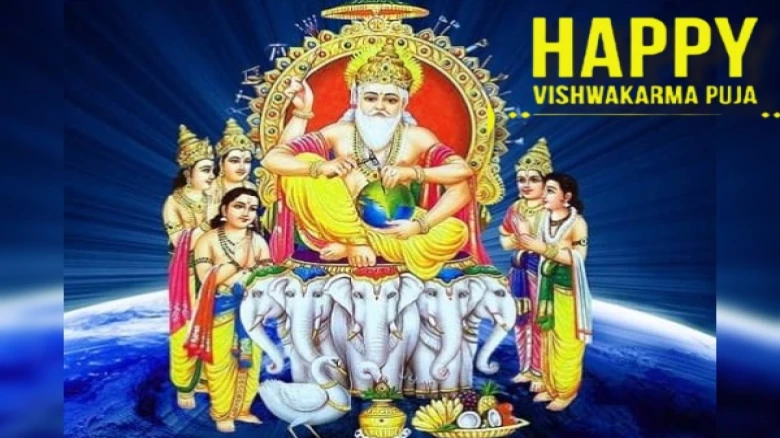Regional

Vishwakarma Jayanti is also observed in Nepal, alongside India...
Digital Desk: Vishwakarma Day, also known as Vishwakarma Jayanti or Vishwakarma Puja, is a major event for Hindus to commemorate and celebrate Lord Vishwakarma, who is revered as the Lord of Creation.
Every year on the last day of the Indian Bhado month, Uttar Pradesh, Bihar, Assam, Jharkhand, Karnataka, Bengal, Odisha, and Tripura celebrate Vishwakarma Puja. Vishwakarma Jayanti is also observed in Nepal, alongside India.
On September 17, the Hindu God Vishwakarma, the almighty creator, is honoured, and this is known as Vishwakarma Jayanti. Because the Vishwakarma festival honours the deity of architecture, it is mostly honoured by factories, stores, and industries.
Well how many of you know about the creator deity, it's been said that Lord Vishwakarma is regarded as the world's first architect and engineer, having assisted in the construction of several structures and laying the groundwork for the universe's development. He is hailed as the heavenly architect of the universe's tools, machines, and buildings.
Lord Vishwakarma is renowned and worshipped for his role in accuracy and inventiveness in creating the world.
The great creator who built Dwarka, the sacred city where Lord Krishna ruled. Vishwakarma is also known as the divine carpenter in the Rig Veda because he created numerous extraordinary weapons for the gods.
Vishwakarma Puja, which is mostly held in India and Nepal. Every year, it falls on September 17th or 18th. Workers and craftspeople pay honour to Lord Vishwakarma on this day by performing rituals and decorating their equipment and machinery.
Vishwakarma Puja 2023 Rituals and Puja Vidhi:
Workplaces, industries, and workshops are meticulously cleaned and adorned before to the puja. This entails cleaning tools, machinery, and equipment, as well as decorating them with flowers and beautiful rangoli.
An idol or image of Lord Vishwakarma is put in a central spot within the workspace.
The puja begins with the recitation of Vedic hymns and mantras. Artists and workers assemble before Lord Vishwakarma's idol to pray for success, prosperity, and safety in their profession.
Flowers, fruits, sweets, and other auspicious objects are traditionally offered at Vishwakarma Puja.
Aarti is a ceremony in which a lamp or camphor flame is waved in front of the deity.
Following the puja, prasad (blessed food) is delivered to the participants and staff. It is considered a sacred offering and is thought to bring good fortune.
Individual preferences and regional customs may influence the objects or Samagri required for Vishwakarma Puja. However, below is a broad list of objects that are frequently used during Vishwakarma Puja:
Lord Vishwakarma Idol or Image: A statue or image of Lord Vishwakarma, the god being honoured during the puja.
Puja Thali- A plate or tray used to contain different puja objects.
Rice- A ritual offering of rice.
Fresh flowers are utilised as decorations and as offerings.
Sandalwood paste and incense: These are used for fragrance and as a sacrifice to the deity.
Coconut- During puja, coconuts are frequently smashed as a sign of overcoming hurdles.
Camphor- Used during puja for aarti (the ceremony of waving lit camphor).
Oil lamps, also known as diyas, are used for lighting and offerings during the ritual.
Fruits- Prasad (divine offering) and for consumption following the puja.
Sweets- Traditional sweets such as ladoos, modaks, and other Lord Vishwakarma favourites.
Betel Leaves and Nuts: These are occasionally offered as part of the puja.
Red cloth is used as a backdrop or to cover the idol or image.
Mauli (Holy Thread): A symbol of protection worn around the wrist or tied to an idol.
Coins- Presented as a symbol of wealth.
Miniature tools and instruments are used because Lord Vishwakarma is the holy architect and craftsman.
Akshata (Unbroken Rice Grains): Used in different puja rites.
Ganga Jal (Holy Water): Used for purification.
Bell: Rings during the puja to summon the deity's presence.
Panchamrit- Milk, curd, ghee, honey, and sugar concoction used for abhishek (ritual bathing of the god).
Red Chandan (Sandalwood Paste): This paste is used for tilak (forehead mark) and adornment.
With Lord Vishwakarma's blessing, may we guide ourselves on the path of advancement and sustainable development in harmony with the environment, Happy Vishwakarma Puja to everyone.
Leave A Comment